算法分析与设计实验六
实验六:遗传算法求解TSP问题实验2篇
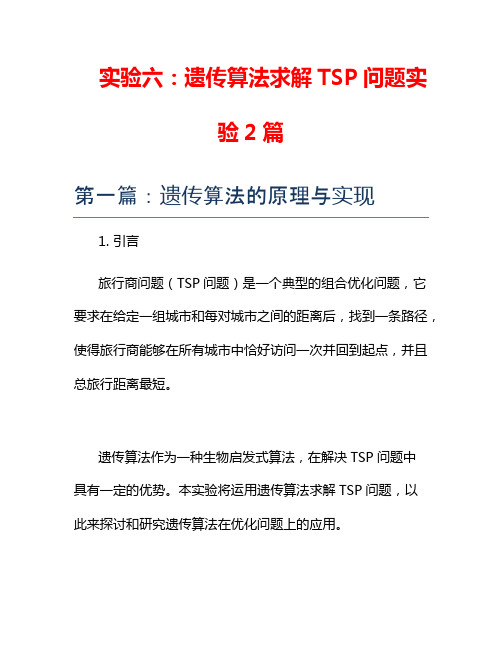
实验六:遗传算法求解TSP问题实验2篇第一篇:遗传算法的原理与实现1. 引言旅行商问题(TSP问题)是一个典型的组合优化问题,它要求在给定一组城市和每对城市之间的距离后,找到一条路径,使得旅行商能够在所有城市中恰好访问一次并回到起点,并且总旅行距离最短。
遗传算法作为一种生物启发式算法,在解决TSP问题中具有一定的优势。
本实验将运用遗传算法求解TSP问题,以此来探讨和研究遗传算法在优化问题上的应用。
2. 遗传算法的基本原理遗传算法是模拟自然界生物进化过程的一种优化算法。
其基本原理可以概括为:选择、交叉和变异。
(1)选择:根据问题的目标函数,以适应度函数来评估个体的优劣程度,并按照适应度值进行选择,优秀的个体被保留下来用于下一代。
(2)交叉:从选出的个体中随机选择两个个体,进行基因的交换,以产生新的个体。
交叉算子的选择及实现方式会对算法效果产生很大的影响。
(3)变异:对新生成的个体进行基因的变异操作,以保证算法的搜索能够足够广泛、全面。
通过选择、交叉和变异操作,不断迭代生成新一代的个体,遗传算法能够逐步优化解,并最终找到问题的全局最优解。
3. 实验设计与实施(1)问题定义:给定一组城市和每对城市之间的距离数据,要求找到一条路径,访问所有城市一次并回到起点,使得旅行距离最短。
(2)数据集准备:选择适当规模的城市数据集,包括城市坐标和每对城市之间的距离,用于验证遗传算法的性能。
(3)遗传算法的实现:根据遗传算法的基本原理,设计相应的选择、交叉和变异操作,确定适应度函数的定义,以及选择和优化参数的设置。
(4)实验流程:a. 初始化种群:随机生成初始种群,每个个体表示一种解(路径)。
b. 计算适应度:根据适应度函数,计算每个个体的适应度值。
c. 选择操作:根据适应度值选择一定数量的个体,作为下一代的父代。
d. 交叉操作:对父代进行交叉操作,生成新的个体。
e. 变异操作:对新生成的个体进行变异操作,以增加搜索的多样性。
《算法设计与分析》实验报告实验一...

《算法设计与分析》实验报告实验一递归与分治策略应用基础学号:**************姓名:*************班级:*************日期:2014-2015学年第1学期第九周一、实验目的1、理解递归的概念和分治法的基本思想2、了解适用递归与分治策略的问题类型,并能设计相应的分治策略算法3、掌握递归与分治算法时间空间复杂度分析,以及问题复杂性分析方法二、实验内容任务:以下题目要求应用递归与分治策略设计解决方案,本次实验成绩按百分制计,完成各小题的得分如下,每小题要求算法描述准确且程序运行正确。
1、求n个元素的全排。
(30分)2、解决一个2k*2k的特殊棋牌上的L型骨牌覆盖问题。
(30分)3、设有n=2k个运动员要进行网球循环赛。
设计一个满足要求的比赛日程表。
(40分)提交结果:算法设计分析思路、源代码及其分析说明和测试运行报告。
三、设计分析四、算法描述及程序五、测试与分析六、实验总结与体会#include "iostream"using namespace std;#define N 100void Perm(int* list, int k, int m){if (k == m){for (int i=0; i<m; i++)cout << list[i] << " ";cout << endl;return;}else{for (int i=m; i<k; i++){swap(list[m], list[i]);Perm(list, k, m+1);swap(list[m], list[i]);}}}void swap(int a,int b){int temp;temp=a;a=b;b=temp;}int main(){int i,n;int a[N];cout<<"请输入排列数据总个数:";cin>>n;cout<<"请输入数据:";for(i=0;i<n;i++){cin>>a[i];}cout<<"该数据的全排列:"<<endl;Perm(a,n,0);return 0;}《算法设计与分析》实验报告实验二递归与分治策略应用提高学号:**************姓名:*************班级:*************日期:2014-2015学年第1学期一、实验目的1、深入理解递归的概念和分治法的基本思想2、正确使用递归与分治策略设计相应的问题的算法3、掌握递归与分治算法时间空间复杂度分析,以及问题复杂性分析方法二、实验内容任务:从以下题目中任选一题完成,要求应用递归与分治策略设计解决方案。
MATLAB实验遗传算法与优化设计
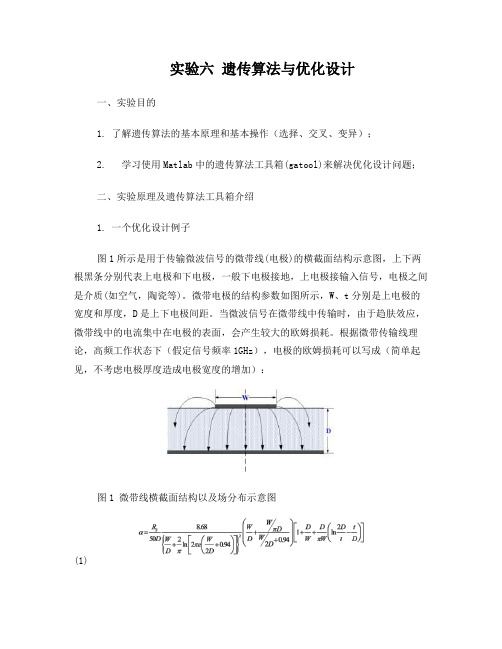
实验六遗传算法与优化设计一、实验目的1. 了解遗传算法的基本原理和基本操作(选择、交叉、变异);2. 学习使用Matlab中的遗传算法工具箱(gatool)来解决优化设计问题;二、实验原理及遗传算法工具箱介绍1. 一个优化设计例子图1所示是用于传输微波信号的微带线(电极)的横截面结构示意图,上下两根黑条分别代表上电极和下电极,一般下电极接地,上电极接输入信号,电极之间是介质(如空气,陶瓷等)。
微带电极的结构参数如图所示,W、t分别是上电极的宽度和厚度,D是上下电极间距。
当微波信号在微带线中传输时,由于趋肤效应,微带线中的电流集中在电极的表面,会产生较大的欧姆损耗。
根据微带传输线理论,高频工作状态下(假定信号频率1GHz),电极的欧姆损耗可以写成(简单起见,不考虑电极厚度造成电极宽度的增加):图1 微带线横截面结构以及场分布示意图(1)其中为金属的表面电阻率,为电阻率。
可见电极的结构参数影响着电极损耗,通过合理设计这些参数可以使电极的欧姆损耗做到最小,这就是所谓的最优化问题或者称为规划设计问题。
此处设计变量有3个:W、D、t,它们组成决策向量[W, D ,t] T,待优化函数称为目标函数。
上述优化设计问题可以抽象为数学描述:(2)其中是决策向量,x1,…,xn为n个设计变量。
这是一个单目标的数学规划问题:在一组针对决策变量的约束条件下,使目标函数最小化(有时也可能是最大化,此时在目标函数前添个负号即可)。
满足约束条件的解X称为可行解,所有满足条件的X组成问题的可行解空间。
2. 遗传算法基本原理和基本操作遗传算法(Genetic Algorithm, GA)是一种非常实用、高效、鲁棒性强的优化技术,广泛应用于工程技术的各个领域(如函数优化、机器学习、图像处理、生产调度等)。
遗传算法是模拟生物在自然环境中的遗传和进化过程而形成的一种自适应全局优化算法。
按照达尔文的进化论,生物在进化过程中“物竞天择”,对自然环境适应度高的物种被保留下来,适应度差的物种而被淘汰。
算法课设实验报告(3篇)

第1篇一、实验背景与目的随着计算机技术的飞速发展,算法在计算机科学中扮演着至关重要的角色。
为了加深对算法设计与分析的理解,提高实际应用能力,本实验课程设计旨在通过实际操作,让学生掌握算法设计与分析的基本方法,学会运用所学知识解决实际问题。
二、实验内容与步骤本次实验共分为三个部分,分别为排序算法、贪心算法和动态规划算法的设计与实现。
1. 排序算法(1)实验目的:熟悉常见的排序算法,理解其原理,比较其优缺点,并实现至少三种排序算法。
(2)实验内容:- 实现冒泡排序、快速排序和归并排序三种算法。
- 对每种算法进行时间复杂度和空间复杂度的分析。
- 编写测试程序,对算法进行性能测试,比较不同算法的优劣。
(3)实验步骤:- 分析冒泡排序、快速排序和归并排序的原理。
- 编写三种排序算法的代码。
- 分析代码的时间复杂度和空间复杂度。
- 编写测试程序,生成随机测试数据,测试三种算法的性能。
- 比较三种算法的运行时间和内存占用。
2. 贪心算法(1)实验目的:理解贪心算法的基本思想,掌握贪心算法的解题步骤,并实现一个贪心算法问题。
(2)实验内容:- 实现一个贪心算法问题,如活动选择问题。
- 分析贪心算法的正确性,并证明其最优性。
(3)实验步骤:- 分析活动选择问题的贪心策略。
- 编写贪心算法的代码。
- 分析贪心算法的正确性,并证明其最优性。
- 编写测试程序,验证贪心算法的正确性。
3. 动态规划算法(1)实验目的:理解动态规划算法的基本思想,掌握动态规划算法的解题步骤,并实现一个动态规划算法问题。
(2)实验内容:- 实现一个动态规划算法问题,如背包问题。
- 分析动态规划算法的正确性,并证明其最优性。
(3)实验步骤:- 分析背包问题的动态规划策略。
- 编写动态规划算法的代码。
- 分析动态规划算法的正确性,并证明其最优性。
- 编写测试程序,验证动态规划算法的正确性。
三、实验结果与分析1. 排序算法实验结果:- 冒泡排序:时间复杂度O(n^2),空间复杂度O(1)。
算法实验报告范文

算法实验报告范文《算法设计与分析》实验报告班级姓名学号年月日目录实验一二分查找程序实现…………………………………………………………………03页实验二棋盘覆盖问题(分治法).…………………………………………………………08页实验三0-1背包问题的动态规划算法设计……………………………………………….11页实验四背包问题的贪心算法………………………………………………………………14页实验五最小重量机器设计问题(回溯法)………………………………………………17页实验六最小重量机器设计问题(分支限界法)…………………………………………20页指导教师对实验报告的评语成绩:指导教师签字:年月日2实验一:二分查找程序实现一、实验时间:2022年10月8日,星期二,第一、二节地点:J13#328二、实验目的及要求目的:1、用c/c++语言实现二分搜索算法。
2、通过随机产生有序表的方法,测出在平均意义下算法比较次数随问题规模的变化曲线,并作图。
三、实验环境平台:Win732位操作系统开发工具:Codeblock10.05四、实验内容对已经排好序的n个元素a[0:n-1],现在要在这n个元素中找出一特定元素某。
五、算法描述及实验步骤算法描述:折半查找法也称为二分查找法,它充分利用了元素间的次序关系,采用分治策略,可在最坏的情况下用O(logn)完成搜索任务。
它的基本思想是,将n个元素分成个数大致相同的两半,取a[n/2]与欲查找的某作比较,如果某=a[n/2]则找到某,算法终止。
如果某a[n/2],则我们只要在数组a的右半部继续搜索某。
二分搜索法的应用极其广泛,而且它的思想易于理解。
确定算法复杂度基本步骤:1、首先设定问题规模n;2、随即产生递增数列;3、在n个有序数中随机取一个作为待查找量,搜索之;4、记录查找过程中的比较次数,再次生成新的有序表并查找,记录查找次数,每个数组重复10次;5、改变问题规模n重复上述步骤2~4,n取100、200……1000;6、依实验数据作图,并与理论图作比较;7、二分搜索算法平均查找次数:问题规模为n时,平均查找次数为:A(n)=Int(logn)+1/2//Int()函数为向下取整3即二分搜索算法对于含有n个数据的有序表L平均作了约Int(logn)+1/2次的查找操作。
实验六、SHA-1算法的实现

#endif
#define SHA1HashSize 20
typedef struct SHA1Context
...{
DWORD Intermediate_Hash[SHA1HashSize/4]; // Message Digest
DWORD Length_Low; // Message length in bits
message_array++;
}
return shaSuccess;
}
void SHA1ProcessMessageBlock(SHA1Context *context)
...{
const DWORD K[] = ...{ 0x5A827999, 0x6ED9EBA1, 0x8F1BBCDC, 0xCA62C1D6 };
D = C;
C = SHA1CircularShift(30,B);
B = A;
A = temp;
}
context->Intermediate_Hash[0] += A;
context->Intermediate_Hash[1] += B;
context->Intermediate_Hash[2] += C;
D = context->Intermediate_Hash[3];
E = context->Intermediate_Hash[4];
for(t = 0; t < 20; t++)
...{
temp = SHA1CircularShift(5,A) +
((B & C) | ((~B) & D)) + E + W[t] + K[0];
算法分析与设计实验报告合并排序快速排序

算法分析与设计实验报告:合并排序与快速排序一、引言算法是计算机科学中非常重要的一部分,它涉及到解决问题的方法和步骤。
合并排序和快速排序是两种经典而常用的排序算法。
本文将对这两种排序算法进行分析和设计实验,通过对比它们的性能和效率,以期得出最优算法。
二、合并排序合并排序是一种分治算法,它将原始数组不断分解为更小的数组,直到最后细分为单个元素。
然后,再将这些单个元素两两合并,形成一个有序数组。
合并排序的核心操作是合并两个有序的数组。
1. 算法步骤(1)将原始数组分解为更小的子数组,直到每个子数组只有一个元素;(2)两两合并相邻的子数组,同时进行排序,生成新的有序数组;(3)重复步骤(2),直到生成最终的有序数组。
2. 算法性能合并排序的最优时间复杂度为O(nlogn),其中n为待排序数组的长度。
无论最好情况还是最坏情况,合并排序的复杂度都相同。
合并排序需要额外的存储空间来存储临时数组,所以空间复杂度为O(n)。
三、快速排序快速排序也是一种分治算法,它将原始数组根据一个主元(pivot)分成两个子数组,一个子数组的元素都小于主元,另一个子数组的元素都大于主元。
然后,递归地对这两个子数组进行排序,最后得到有序数组。
快速排序的核心操作是划分。
1. 算法步骤(1)选择一个主元(pivot),可以是随机选择或者固定选择第一个元素;(2)将原始数组根据主元划分为两个子数组,一个子数组的元素都小于主元,另一个子数组的元素都大于主元;(3)递归地对这两个子数组进行快速排序;(4)重复步骤(2)和(3),直到每个子数组只有一个元素,即得到最终的有序数组。
2. 算法性能快速排序的平均时间复杂度为O(nlogn),其中n为待排序数组的长度。
最坏情况下,当每次选择的主元都是最小或最大元素时,时间复杂度为O(n^2)。
快速排序是原地排序,不需要额外的存储空间,所以空间复杂度为O(1)。
四、实验设计为了验证合并排序和快速排序的性能和效率,我们设计以下实验:1. 实验目的:比较合并排序和快速排序的时间复杂度和空间复杂度。
算法与分析实验报告

算法与分析实验报告一、引言算法是现代计算机科学中的核心概念,通过合理设计的算法可以解决复杂的问题,并提高计算机程序的执行效率。
本次实验旨在通过实际操作和数据统计,对比分析不同算法的执行效率,探究不同算法对于解决特定问题的适用性和优劣之处。
二、实验内容本次实验涉及两个经典的算法问题:排序和搜索。
具体实验内容如下:1. 排序算法- 冒泡排序- 插入排序- 快速排序2. 搜索算法- 顺序搜索- 二分搜索为了对比不同算法的执行效率,我们需要设计合适的测试用例并记录程序执行时间进行比较。
实验中,我们将使用随机生成的整数数组作为排序和搜索的测试数据,并统计执行时间。
三、实验步骤1. 算法实现与优化- 实现冒泡排序、插入排序和快速排序算法,并对算法进行优化,提高执行效率。
- 实现顺序搜索和二分搜索算法。
2. 数据生成- 设计随机整数数组生成函数,生成不同大小的测试数据。
3. 实验设计- 设计实验方案,包括测试数据的规模、重复次数等。
4. 实验执行与数据收集- 使用不同算法对随机整数数组进行排序和搜索操作,记录执行时间。
- 多次重复同样的操作,取平均值以减小误差。
5. 数据分析与结果展示- 将实验收集到的数据进行分析,并展示在数据表格或图表中。
四、实验结果根据实验数据的收集与分析,我们得到以下结果:1. 排序算法的比较- 冒泡排序:平均执行时间较长,不适用于大规模数据排序。
- 插入排序:执行效率一般,在中等规模数据排序中表现良好。
- 快速排序:执行效率最高,适用于大规模数据排序。
2. 搜索算法的比较- 顺序搜索:执行时间与数据规模成线性关系,适用于小规模数据搜索。
- 二分搜索:执行时间与数据规模呈对数关系,适用于大规模有序数据搜索。
实验结果表明,不同算法适用于不同规模和类型的问题。
正确选择和使用算法可以显著提高程序的执行效率和性能。
五、实验总结通过本次实验,我们深入了解了不同算法的原理和特点,并通过实际操作和数据分析对算法进行了比较和评估。
实验六:遗传算法求解TSP问题实验
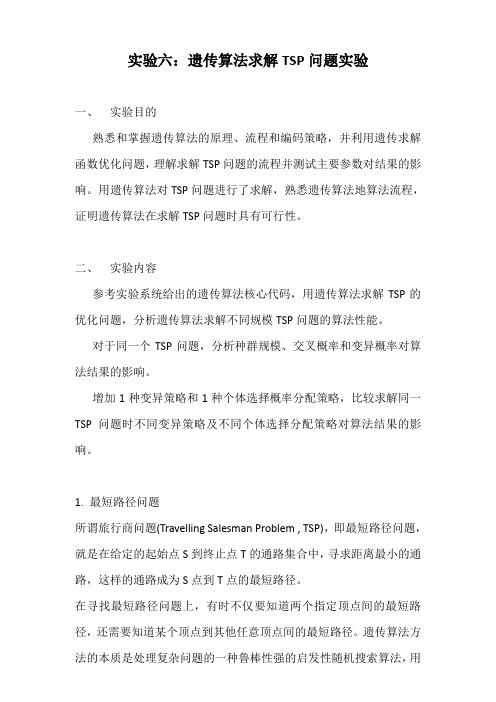
实验六:遗传算法求解TSP问题实验一、实验目的熟悉和掌握遗传算法的原理、流程和编码策略,并利用遗传求解函数优化问题,理解求解TSP问题的流程并测试主要参数对结果的影响。
用遗传算法对TSP问题进行了求解,熟悉遗传算法地算法流程,证明遗传算法在求解TSP问题时具有可行性。
二、实验内容参考实验系统给出的遗传算法核心代码,用遗传算法求解TSP的优化问题,分析遗传算法求解不同规模TSP问题的算法性能。
对于同一个TSP问题,分析种群规模、交叉概率和变异概率对算法结果的影响。
增加1种变异策略和1种个体选择概率分配策略,比较求解同一TSP问题时不同变异策略及不同个体选择分配策略对算法结果的影响。
1. 最短路径问题所谓旅行商问题(Travelling Salesman Problem , TSP),即最短路径问题,就是在给定的起始点S到终止点T的通路集合中,寻求距离最小的通路,这样的通路成为S点到T点的最短路径。
在寻找最短路径问题上,有时不仅要知道两个指定顶点间的最短路径,还需要知道某个顶点到其他任意顶点间的最短路径。
遗传算法方法的本质是处理复杂问题的一种鲁棒性强的启发性随机搜索算法,用遗传算法解决这类问题,没有太多的约束条件和有关解的限制,因而可以很快地求出任意两点间的最短路径以及一批次短路径。
假设平面上有n个点代表n个城市的位置, 寻找一条最短的闭合路径, 使得可以遍历每一个城市恰好一次。
这就是旅行商问题。
旅行商的路线可以看作是对n个城市所设计的一个环形, 或者是对一列n个城市的排列。
由于对n个城市所有可能的遍历数目可达(n- 1)!个, 因此解决这个问题需要0(n!)的计算时间。
假设每个城市和其他任一城市之间都以欧氏距离直接相连。
也就是说, 城市间距可以满足三角不等式, 也就意味着任何两座城市之间的直接距离都小于两城市之间的间接距离。
2. 遗传算法遗传算法是由美国J.Holland教授于1975年在他的专著《自然界和人工系统的适应性》中首先提出的,它是一类借鉴生物界自然选择和自然遗传机制的随机化搜索算法。
算法设计与分析实验报告
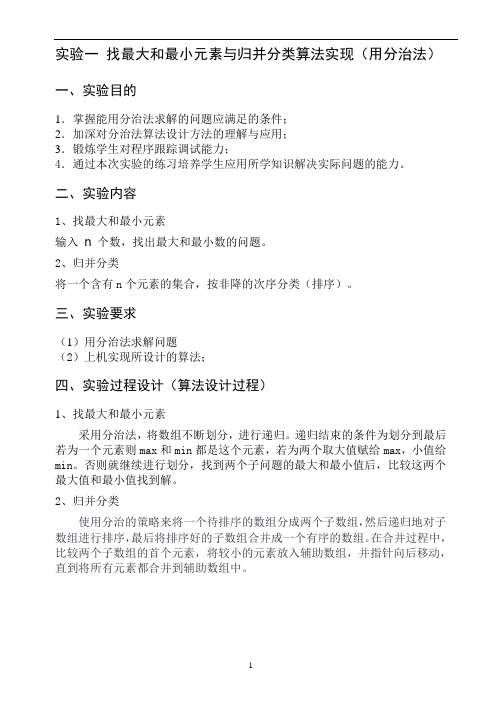
实验一找最大和最小元素与归并分类算法实现(用分治法)一、实验目的1.掌握能用分治法求解的问题应满足的条件;2.加深对分治法算法设计方法的理解与应用;3.锻炼学生对程序跟踪调试能力;4.通过本次实验的练习培养学生应用所学知识解决实际问题的能力。
二、实验内容1、找最大和最小元素输入n 个数,找出最大和最小数的问题。
2、归并分类将一个含有n个元素的集合,按非降的次序分类(排序)。
三、实验要求(1)用分治法求解问题(2)上机实现所设计的算法;四、实验过程设计(算法设计过程)1、找最大和最小元素采用分治法,将数组不断划分,进行递归。
递归结束的条件为划分到最后若为一个元素则max和min都是这个元素,若为两个取大值赋给max,小值给min。
否则就继续进行划分,找到两个子问题的最大和最小值后,比较这两个最大值和最小值找到解。
2、归并分类使用分治的策略来将一个待排序的数组分成两个子数组,然后递归地对子数组进行排序,最后将排序好的子数组合并成一个有序的数组。
在合并过程中,比较两个子数组的首个元素,将较小的元素放入辅助数组,并指针向后移动,直到将所有元素都合并到辅助数组中。
五、源代码1、找最大和最小元素#include<iostream>using namespace std;void MAXMIN(int num[], int left, int right, int& fmax, int& fmin); int main() {int n;int left=0, right;int fmax, fmin;int num[100];cout<<"请输入数字个数:";cin >> n;right = n-1;cout << "输入数字:";for (int i = 0; i < n; i++) {cin >> num[i];}MAXMIN(num, left, right, fmax, fmin);cout << "最大值为:";cout << fmax << endl;cout << "最小值为:";cout << fmin << endl;return 0;}void MAXMIN(int num[], int left, int right, int& fmax, int& fmin) { int mid;int lmax, lmin;int rmax, rmin;if (left == right) {fmax = num[left];fmin = num[left];}else if (right - left == 1) {if (num[right] > num[left]) {fmax = num[right];fmin = num[left];}else {fmax = num[left];fmin = num[right];}}else {mid = left + (right - left) / 2;MAXMIN(num, left, mid, lmax, lmin);MAXMIN(num, mid+1, right, rmax, rmin);fmax = max(lmax, rmax);fmin = min(lmin, rmin);}}2、归并分类#include<iostream>using namespace std;int num[100];int n;void merge(int left, int mid, int right) { int a[100];int i, j,k,m;i = left;j = mid+1;k = left;while (i <= mid && j <= right) {if (num[i] < num[j]) {a[k] = num[i++];}else {a[k] = num[j++];}k++;}if (i <= mid) {for (m = i; m <= mid; m++) {a[k++] = num[i++];}}else {for (m = j; m <= right; m++) {a[k++] = num[j++];}}for (i = left; i <= right; i++) { num[i] = a[i];}}void mergesort(int left, int right) { int mid;if (left < right) {mid = left + (right - left) / 2;mergesort(left, mid);mergesort(mid + 1, right);merge(left, mid, right);}}int main() {int left=0,right;int i;cout << "请输入数字个数:";cin >> n;right = n - 1;cout << "输入数字:";for (i = 0; i < n; i++) {cin >> num[i];}mergesort(left,right);for (i = 0; i < n; i++) {cout<< num[i];}return 0;}六、运行结果和算法复杂度分析1、找最大和最小元素图1-1 找最大和最小元素结果算法复杂度为O(logn)2、归并分类图1-2 归并分类结果算法复杂度为O(nlogn)实验二背包问题和最小生成树算法实现(用贪心法)一、实验目的1.掌握能用贪心法求解的问题应满足的条件;2.加深对贪心法算法设计方法的理解与应用;3.锻炼学生对程序跟踪调试能力;4.通过本次实验的练习培养学生应用所学知识解决实际问题的能力。
计算机算法设计与分析实验指导书
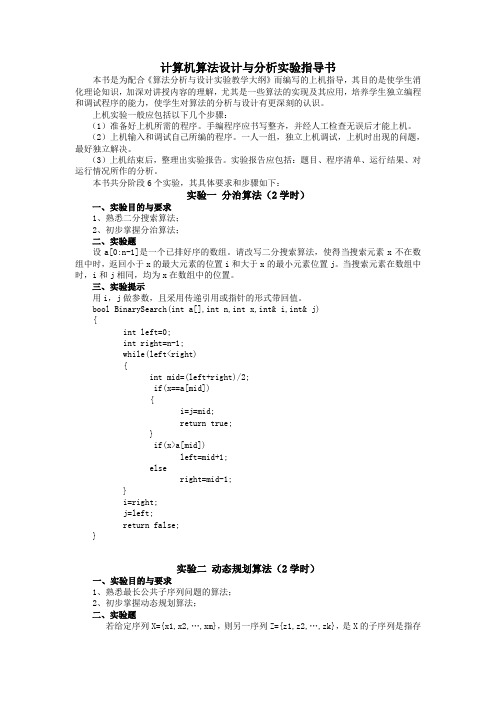
计算机算法设计与分析实验指导书本书是为配合《算法分析与设计实验教学大纲》而编写的上机指导,其目的是使学生消化理论知识,加深对讲授内容的理解,尤其是一些算法的实现及其应用,培养学生独立编程和调试程序的能力,使学生对算法的分析与设计有更深刻的认识。
上机实验一般应包括以下几个步骤:(1)准备好上机所需的程序。
手编程序应书写整齐,并经人工检查无误后才能上机。
(2)上机输入和调试自己所编的程序。
一人一组,独立上机调试,上机时出现的问题,最好独立解决。
(3)上机结束后,整理出实验报告。
实验报告应包括:题目、程序清单、运行结果、对运行情况所作的分析。
本书共分阶段6个实验,其具体要求和步骤如下:实验一分治算法(2学时)一、实验目的与要求1、熟悉二分搜索算法;2、初步掌握分治算法;二、实验题设a[0:n-1]是一个已排好序的数组。
请改写二分搜索算法,使得当搜索元素x不在数组中时,返回小于x的最大元素的位置i和大于x的最小元素位置j。
当搜索元素在数组中时,i和j相同,均为x在数组中的位置。
三、实验提示用i,j做参数,且采用传递引用或指针的形式带回值。
bool BinarySearch(int a[],int n,int x,int& i,int& j){int left=0;int right=n-1;while(left<right){int mid=(left+right)/2;if(x==a[mid]){i=j=mid;return true;}if(x>a[mid])left=mid+1;elseright=mid-1;}i=right;j=left;return false;}实验二动态规划算法(2学时)一、实验目的与要求1、熟悉最长公共子序列问题的算法;2、初步掌握动态规划算法;二、实验题若给定序列X={x1,x2,…,xm},则另一序列Z={z1,z2,…,zk},是X的子序列是指存在一个严格递增下标序列{i1,i2,…,ik}使得对于所有j=1,2,…,k有:zj=xij。
关于算法的实验报告(3篇)

第1篇一、实验目的1. 理解快速排序算法的基本原理和实现方法。
2. 掌握快速排序算法的时间复杂度和空间复杂度分析。
3. 通过实验验证快速排序算法的效率。
4. 提高编程能力和算法设计能力。
二、实验环境1. 操作系统:Windows 102. 编程语言:C++3. 开发工具:Visual Studio 2019三、实验原理快速排序算法是一种分而治之的排序算法,其基本思想是:选取一个基准元素,将待排序序列分为两个子序列,其中一个子序列的所有元素均小于基准元素,另一个子序列的所有元素均大于基准元素,然后递归地对这两个子序列进行快速排序。
快速排序算法的时间复杂度主要取决于基准元素的选取和划分过程。
在平均情况下,快速排序的时间复杂度为O(nlogn),但在最坏情况下,时间复杂度会退化到O(n^2)。
四、实验内容1. 快速排序算法的代码实现2. 快速排序算法的时间复杂度分析3. 快速排序算法的效率验证五、实验步骤1. 设计快速排序算法的C++代码实现,包括以下功能:- 选取基准元素- 划分序列- 递归排序2. 编写主函数,用于生成随机数组和测试快速排序算法。
3. 分析快速排序算法的时间复杂度。
4. 对不同规模的数据集进行测试,验证快速排序算法的效率。
六、实验结果与分析1. 快速排序算法的代码实现```cppinclude <iostream>include <vector>include <cstdlib>include <ctime>using namespace std;// 生成随机数组void generateRandomArray(vector<int>& arr, int n) {srand((unsigned)time(0));for (int i = 0; i < n; ++i) {arr.push_back(rand() % 1000);}}// 快速排序void quickSort(vector<int>& arr, int left, int right) { if (left >= right) {return;}int i = left;int j = right;int pivot = arr[(left + right) / 2]; // 选取中间元素作为基准 while (i <= j) {while (arr[i] < pivot) {i++;}while (arr[j] > pivot) {j--;}if (i <= j) {swap(arr[i], arr[j]);i++;j--;}}quickSort(arr, left, j);quickSort(arr, i, right);}int main() {int n = 10000; // 测试数据规模vector<int> arr;generateRandomArray(arr, n);clock_t start = clock();quickSort(arr, 0, n - 1);clock_t end = clock();cout << "排序用时:" << double(end - start) / CLOCKS_PER_SEC << "秒" << endl;return 0;}```2. 快速排序算法的时间复杂度分析根据实验结果,快速排序算法在平均情况下的时间复杂度为O(nlogn),在最坏情况下的时间复杂度为O(n^2)。
江西理工大学实验报告(示例)

江西理工大学算法分析与设计课程实验报告实验递归与分治策略专业班级计算机122班实验人xxxx学号XXXXXXXX(8位)实验日期2014年5月12日同组人XXX_____________________________________________________________________________ 一、实验目的1.加深学生对分治法算法设计方法的基本思想、基本步骤、基本方法的理解与掌握;2.提高学生利用课堂所学知识解决实际问题的能力;3.提高学生综合应用所学知识解决实际问题的能力。
二、实验内容设计一个递归和分治算法,找出数组的最大元素,找出x在数组A中出现的次数。
三、实验要求1.用分治法求解问题;2.再选择自己熟悉的其它方法求解本问题;3.上机实现所设计的所有算法。
四、实验过程设计(算法设计过程)1. 设计一个递归算法,找出数组的最大元素。
2. 设计一个分治算法,找出x在数组A中出现的次数。
3. 写一个主函数,调用上述算法。
五、实验结果和分析实验结果:E:\学习\计算机实验\算法\debug\递归.exe数组的最大元素为544输入想要计数的数组元素:77在数组中出现的次数为2次Press any key to continue实验分析(分析时空复杂性,设计测试用例及测试结果):时间复杂性:最好情况下,O(n)最坏情况下:O(nlog(n)空间复杂性分析:O(n)六、实验体会通过写递归与分治策略实验,更加清楚的知道它的运行机理,分治法解题的一般步骤:1.分解,将要解决的问题划分成若干规模较小的同类问题;2.求解,当子问题划分得足够小时,用较简单的方法解决;3.合并,按原问题的要求,将子问题的解逐层合并构成原问题的解。
做实验重在动手动脑,还是要多写写实验,才是硬道理。
七、附录(源代码)#include"stdio.h"#define ElemTypeintintcount(ElemType a[],inti,intj,ElemType x){int k=0,mid; //k用来计数,记录数组中x出现的次数if(i==j){if(a[i]==x) k++;return k;}else{mid=(i+j)/2;k+=count(a,i,mid,x);k+=count(a,mid+1,j,x);}return k;}ElemTypeMaxitem(ElemType a[],int n){ElemType max=a[n-1],j;if(n==1){max=a[n-1];return max;}else{j=Maxitem(a,n-1);if(j>max) max=j;return max;}}void main(void){ElemTypea[]={1,5,2,7,3,7,4,8,9,5,4,544,2,4,123};ElemType b;ElemType x;int n;printf("数组的最大元素为%d\n",b);printf("输入想要计数的数组元素:\n");scanf("%d",&x);n=count(a,0,14,x);printf("%d在数组中出现的次数为%d次\n",x,n); }。
《算法设计与分析》教案
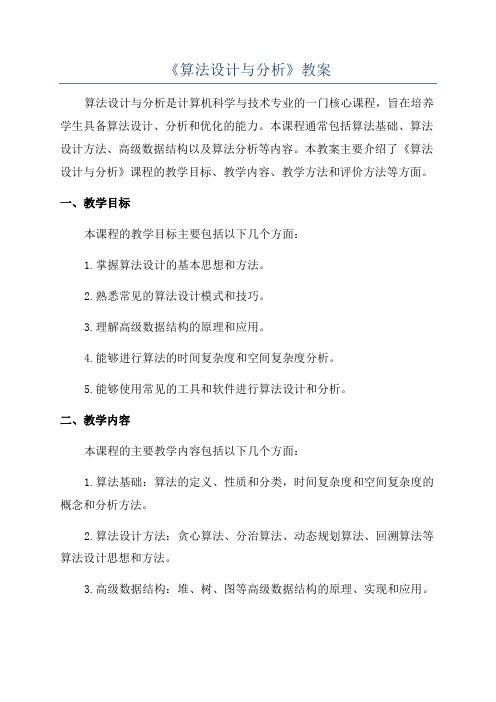
《算法设计与分析》教案算法设计与分析是计算机科学与技术专业的一门核心课程,旨在培养学生具备算法设计、分析和优化的能力。
本课程通常包括算法基础、算法设计方法、高级数据结构以及算法分析等内容。
本教案主要介绍了《算法设计与分析》课程的教学目标、教学内容、教学方法和评价方法等方面。
一、教学目标本课程的教学目标主要包括以下几个方面:1.掌握算法设计的基本思想和方法。
2.熟悉常见的算法设计模式和技巧。
3.理解高级数据结构的原理和应用。
4.能够进行算法的时间复杂度和空间复杂度分析。
5.能够使用常见的工具和软件进行算法设计和分析。
二、教学内容本课程的主要教学内容包括以下几个方面:1.算法基础:算法的定义、性质和分类,时间复杂度和空间复杂度的概念和分析方法。
2.算法设计方法:贪心算法、分治算法、动态规划算法、回溯算法等算法设计思想和方法。
3.高级数据结构:堆、树、图等高级数据结构的原理、实现和应用。
4.算法分析:渐进分析法、均摊分析法、递归方程求解等算法分析方法。
5. 算法设计与分析工具:常见的算法设计和分析工具,如C++、Java、Python和MATLAB等。
三、教学方法本课程采用多种教学方法结合的方式,包括讲授、实践和讨论等。
1.讲授:通过教师讲解理论知识,引导学生掌握算法的基本思想和方法。
2.实践:通过课堂上的编程实验和课后作业,培养学生动手实践的能力。
3.讨论:通过小组讨论和学生报告,促进学生之间的交流和合作,提高学习效果。
四、评价方法为了全面评价学生的学习情况,本课程采用多种评价方法,包括考试、作业和实验报告等。
1.考试:通过期中考试和期末考试,检验学生对算法设计和分析的理解和掌握程度。
2.作业:通过课后作业,检验学生对算法设计和分析的实践能力。
3.实验报告:通过编程实验和实验报告,检验学生对算法设计和分析工具的应用能力。
五、教学资源为了支持教学工作,我们为学生准备了如下教学资源:1.课件:编写了详细的教学课件,包括理论知识的讲解和案例分析。
算法设计与分析实验报告

本科实验报告课程名称:算法设计与分析实验项目:递归与分治算法实验地点:计算机系实验楼110专业班级:物联网1601 学号:2016002105 学生姓名:俞梦真指导教师:郝晓丽2018年05月04 日实验一递归与分治算法1.1 实验目的与要求1.进一步熟悉C/C++语言的集成开发环境;2.通过本实验加深对递归与分治策略的理解和运用。
1.2 实验课时2学时1.3 实验原理分治(Divide-and-Conquer)的思想:一个规模为n的复杂问题的求解,可以划分成若干个规模小于n的子问题,再将子问题的解合并成原问题的解。
需要注意的是,分治法使用递归的思想。
划分后的每一个子问题与原问题的性质相同,可用相同的求解方法。
最后,当子问题规模足够小时,可以直接求解,然后逆求原问题的解。
1.4 实验题目1.上机题目:格雷码构造问题Gray码是一个长度为2n的序列。
序列无相同元素,每个元素都是长度为n的串,相邻元素恰好只有一位不同。
试设计一个算法对任意n构造相应的Gray码(分治、减治、变治皆可)。
对于给定的正整数n,格雷码为满足如下条件的一个编码序列。
(1)序列由2n个编码组成,每个编码都是长度为n的二进制位串。
(2)序列中无相同的编码。
(3)序列中位置相邻的两个编码恰有一位不同。
2.设计思想:根据格雷码的性质,找到他的规律,可发现,1位是0 1。
两位是00 01 11 10。
三位是000 001 011010 110 111 101 100。
n位是前n-1位的2倍个。
N-1个位前面加0,N-2为倒转再前面再加1。
3.代码设计:}}}int main(){int n;while(cin>>n){get_grad(n);for(int i=0;i<My_grad.size();i++)cout<<My_grad[i]<<endl;My_grad.clear();}return 0;}运行结果:1.5 思考题(1)递归的关键问题在哪里?答:1.递归式,就是如何将原问题划分成子问题。
《算法设计与分析》实验目的

《算法设计与分析》实验指导书曹严元计算机与信息科学学院2007年5月目录实验一递归算法与非递归算法 (2)实验二分治算法 ................................................... 错误!未定义书签。
实验三贪心算法 (3)实验四动态规划 (2)实验五回溯法 (3)实验六分枝—限界算法 (4)实验七课程设计 (4)实验一递归与分治算法实验目的1.了解并掌握递归的概念,掌握递归算法的基本思想;2.掌握分治法的基本思想方法;3.了解适用于用递归与分治求解的问题类型,并能设计相应递归与分治算法;4.掌握递归与分治算法复杂性分析方法,比较同一个问题的递归算法与循环迭代算法的效率。
实验二动态规划实验目的1.掌握动态规划的基本思想方法;2.了解适用于用动态规划方法求解的问题类型,并能设计相应动态规划算法;3.掌握动态规划算法复杂性分析方法。
实验三贪心算法实验目的1.掌握贪心法的基本思想方法;2.了解适用于用贪心法求解的问题类型,并能设计相应贪心法算法;3.掌握贪心算法复杂性分析方法分析问题复杂性。
实验五回溯法实验目的1.掌握回溯法的基本思想方法;2.了解适用于用回溯法求解的问题类型,并能设计相应回溯法算法;3.掌握回溯法算法复杂性分析方法,分析问题复杂性。
实验六 分枝—限界算法实验目的1. 掌握分枝—限界的基本思想方法;2. 了解适用于用分枝—限界方法求解的问题类型,并能设计相应动态规划算法;3. 掌握分枝—限界算法复杂性分析方法,分析问题复杂性。
实验七 课程设计实验目的1. 在已学的算法基本设计方法的基础上,理解算法设计的基本思想方法;2. 掌握对写出的算法的复杂性分析的方法,理解算法效率的重要性;3. 能运用所学的基本算法设计方法对问题设计相应算法,分析其效率,并建立对算法进行改进,提高效率的思想意识。
预习与实验要求1. 预习实验指导书及教材的有关内容,回顾所学过的算法的基本思想;2. 严格按照实验内容进行实验,培养良好的算法设计和编程的习惯;3. 认真听讲,服从安排,独立思考并完成实验。
算法设计与分析实验指导书(080200050)

算法设计与分析实验指导书东北大学软件学院2014年目录算法设计与分析 (1)实验指导书 (1)前言 (3)实验要求 (4)实验1 分治法的应用(2学时) (5)1.实验目的 (5)2.实验类型 (5)3.预习要求 (5)4.实验基本要求 (5)5.实验基本步骤 (7)实验2动态规划(2学时) (9)1.实验目的 (9)2.实验类型 (9)3.预习要求 (9)4.实验基本要求 (9)5.实验基本步骤 (10)实验3 回溯法(4学时) (12)1.实验目的 (12)2.实验类型 (12)3.预习要求 (12)4.实验基本要求 (12)5.实验基本步骤 (13)前言《算法设计与分析》是一门面向设计,处于计算机科学与技术学科核心地位的教育课程。
通过对计算机算法系统的学习,使学生理解和掌握计算机算法的通用设计方法,培养对算法的计算复杂性正确分析的能力,为独立设计算法和对算法进行复杂性分析奠定基础。
要求掌握算法复杂度分析、分治法、动态规划法、贪心法、回溯法、分支限界法等算法的设计方法及其分析方法。
能将这些方法灵活的应用到相应的问题中,并且能够用C++实现所涉及的算法,并尽量做到低复杂度,高效率。
通过本课程的实验,使学生加深对课程内容的理解,培养学生严密的思维能力,运用所学知识结合具体问题设计适用的算法的能力;培养学生良好的设计风格,激励学生创造新算法和改进旧算法的愿望和热情。
希望同学们能够充分利用实验条件,认真完成实验,从实验中得到应有的锻炼和培养。
希望同学们在使用本实验指导书及进行实验的过程中,能够帮助我们不断地发现问题,并提出建议,使《算法设计与分析》课程成为对大家有益的课程。
实验要求《算法设计与分析》课程实验的目的是为了使学生在课堂学习的同时,通过一系列的实验,使学生加深理解和更好地掌握《算法设计与分析》课程教学大纲要求的内容。
在《算法设计与分析》的课程实验过程中,要求学生做到:(1)仔细观察调试程序过程中出现的各种问题,记录主要问题,做出必要说明和分析。
算法设计与分析课程设计(完整版)

HUNAN CITY UNIVERSITY 算法设计与分析课程设计题目:求最大值与最小值问题专业:学号:姓名:指导教师:成绩:二0年月日一、问题描述输入一列整数,求出该列整数中的最大值与最小值。
二、课程设计目的通过课程设计,提高用计算机解决实际问题的能力,提高独立实践的能力,将课本上的理论知识和实际有机的结合起来,锻炼分析解决实际问题的能力。
提高适应实际,实践编程的能力。
在实际的编程和调试综合试题的基础上,把高级语言程序设计的思想、编程巧和解题思路进行总结与概括,通过比较系统地练习达到真正比较熟练地掌握计算机编程的基本功,为后续的学习打下基础。
了解一般程序设计的基本思路与方法。
三、问题分析看到这个题目我们最容易想到的算法是直接比较算法:将数组的第 1 个元素分别赋给两个临时变量:fmax:=A[1]; fmin:=A[1]; 然后从数组的第 2 个元素 A[2]开始直到第 n个元素逐个与 fmax 和 fmin 比较,在每次比较中,如果A[i] > fmax,则用 A[i]的值替换 fmax 的值;如果 A[i] < fmin,则用 A[i]的值替换 fmin 的值;否则保持 fmax(fmin)的值不变。
这样在程序结束时的fmax、fmin 的值就分别是数组的最大值和最小值。
这个算法在最好、最坏情况下,元素的比较次数都是 2(n-1),而平均比较次数也为 2(n-1)。
如果将上面的比较过程修改为:从数组的第 2 个元素 A[2]开始直到第 n 个元素,每个 A[i]都是首先与 fmax 比较,如果 A[i]>fmax,则用 A[i]的值替换 fmax 的值;否则才将 A[i]与 fmin 比较,如果 A[i] < fmin,则用 A[i]的值替换 fmin 的值。
这样的算法在最好、最坏情况下使用的比较次数分别是 n-1 和 2(n-1),而平均比较次数是 3(n-1)/2,因为在比较过程中,将有一半的几率出现 A[i]>fmax 情况。
- 1、下载文档前请自行甄别文档内容的完整性,平台不提供额外的编辑、内容补充、找答案等附加服务。
- 2、"仅部分预览"的文档,不可在线预览部分如存在完整性等问题,可反馈申请退款(可完整预览的文档不适用该条件!)。
- 3、如文档侵犯您的权益,请联系客服反馈,我们会尽快为您处理(人工客服工作时间:9:00-18:30)。
实验五动态规划实验
一、实验目的
1.掌握动态规划算法的基本思想。
二、实验内容
1、参考教材描述,使用动态规划算法求解多段图的最短路径问题。
#include <iostream.h>
#include <stdlib.h>
#define max_value 10000
#define zero_value 0
typedef struct NODE{
int v_num;
int len;
struct NODE *next;
}LinkStackNode,LinkStack;
/* typedef struct PNODE{
int data;
int len;
struct PNODE *next;
}*LinkStackPnode,*LinkStack;*/
int fgraph(LinkStack top[],int route[],int n)
{ int i;
LinkStackNode *pnode;
int *path=new int[n];
int *cost=new int[n];
int min_cost;
for(i=0;i<n;i++)
{
cost[i]=max_value;
path[i]=-1;
route[i]=0;
}
cost[n-1]=zero_value;
for(i=n-2;i>=0;i--)
{
pnode=top[i].next;
while(pnode!=NULL)
{
if(pnode->len+cost[pnode->v_num]<cost[i])
{
cost[i]=pnode->len+cost[pnode->v_num];
path[i]=pnode->v_num;
}
pnode = pnode-> next;
}
}
i=0;
while((route[i]!=n-1)&&(path[i]!=-1))
{
i++;
route[i]=path[route[i-1]];
}
min_cost=cost[0];
delete path;
delete cost;
return min_cost;
}
int push(LinkStack top[],int i,int x,int y) {
LinkStackNode *temp;
temp=new LinkStackNode;
if(temp==NULL)
return 0;
temp->v_num=x;
temp->len=y;
temp->next=top[i].next;
top[i].next=temp;
return 1;
}
void main()
{
LinkStack top[10];
int cost;
//int route[M];
int route[10];
int a;
//int b;
for (int i = 0; i<10; i++) {
top[i].v_num= i;
top[i].len = 0;
top[i].next = NULL;
}
push(top,0,1,4);
push(top,0,2,1);
push(top,0,3,3);
push(top,1,4,9);
push(top,1,5,6);
push(top,2,3,1);
push(top,2,4,6);
push(top,2,5,7);
push(top,2,6,8);
push(top,3,5,4);
push(top,3,6,7);
push(top,4,7,5);
push(top,4,8,6);
push(top,5,7,8);
push(top,5,8,6);
push(top,6,7,6);
push(top,6,8,5);
push(top,7,9,7);
push(top,8,9,3);
cost=fgraph( top,route,10);
cout<<"min_cost="<<cost<<endl;
//a=route[1];
//cout<<a<<endl;
for(i=0;i<6;i++)
cout<<"最短路径为:"<<route[i]<<endl; }。
